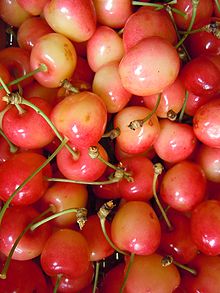Great princess
The Great Princess or Great Princess Cherry , Napoleon Cherry , King Cherry , Kaiser Franz Cherry , Royal Ann , Emperor Francis , Lauermanns Cherry , Dunajka , Bigarreau Napoleon , Wienerin and Herites is a red and white variety of sweet cherries belonging to the cartilage cherries .
origin
The great princess is an ancient variety that was discovered around 1828. The exact origin is unknown, according to a source it is said to come from Werder . As you can see from its many synonyms, it is now widespread worldwide. The variety of Büttner's Rote Cartpelkirsche is very similar , the fruit of which is not quite as thick in the same location. The varieties are otherwise so similar that even experts can often only distinguish them after examining the stones. The fruits are used to make the imperial cherry .
fruit
The fruit is very large, broad and heart-shaped. The skin is predominantly bright yellow and only bright red on the sunny side when fully ripe. The pulp is light yellow and gristly, firm and juicy. The taste is sweet and spicy with a pleasant acidity and remains hard when cooked and becomes even more acidic. It tends to burst when it rains. The stone is small and pointed and easily separates from the flesh. The stem is about 4.5 cm long and stands in a shallow pit. It ripens in the 4th cherry week .
tree
The tree grows very vigorously, spherically and branches pyramidal. Nutrient-rich soil with sufficient moisture is best. Otherwise it has no special climatic requirements. The flowering is medium late and long lasting. Since the variety is self-sterile , it needs a fertilization partner . Hedelfinger giant cherry , earliest of the marrow , Schneider's late cartilage cherry and Dönissen's yellow cartilage cherry are suitable .
literature
- Herbert Bischof: Grandfather's old fruit varieties . Franckh-Kosmos, Stuttgart 1998, ISBN 978-3-440-07398-8 .
